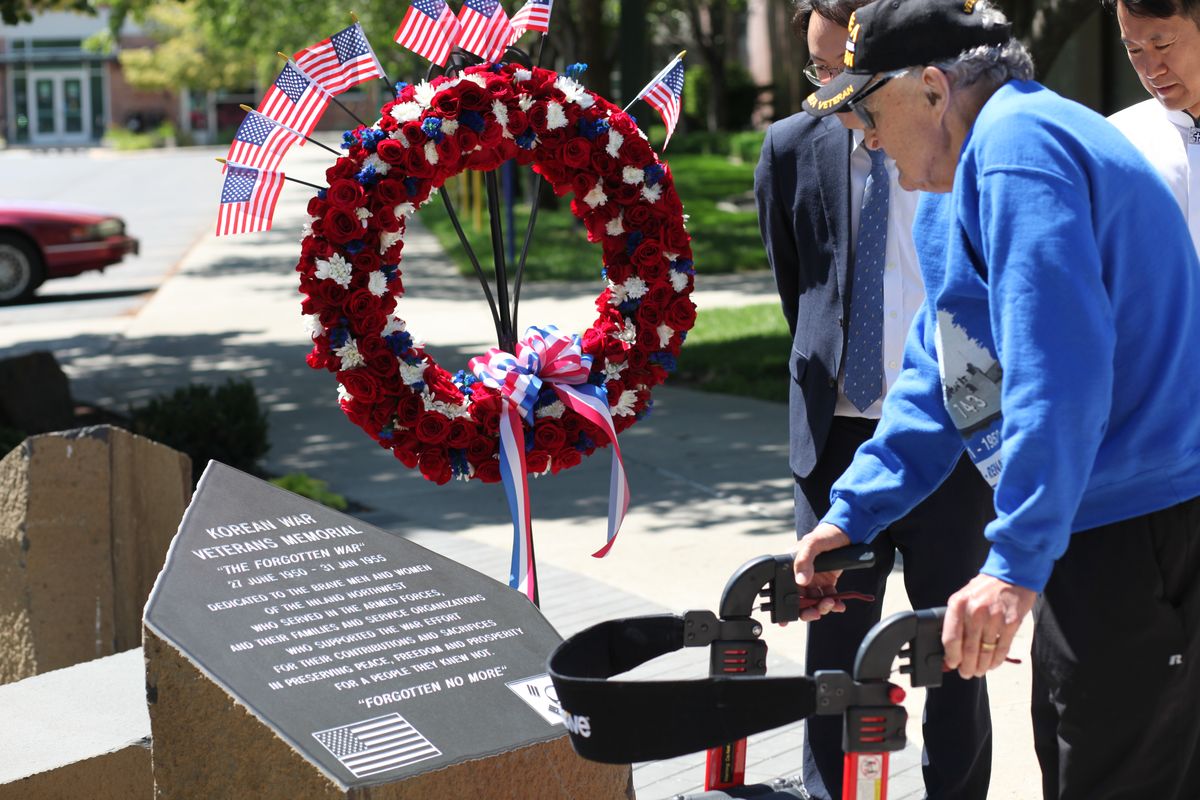Korean War memorial dedicated in downtown Spokane on Sunday anniversary of U.S. involvement

Temperatures near the Spokane Veterans Memorial Arena climbed to near 100 on Sunday afternoon, but you couldn’t get 93-year-old Dick Kirkendall to take off his sweatshirt.
“This sweatshirt was a Father’s Day present from my two daughters,” a beaming Kirkendall told a group of visitors to Sunday’s dedication of a Korean War memorial in Spokane.
Screenprinted on the front was an image of the USS Southerland, where Kirkendall was stationed during the war that America entered 71 years ago Sunday. The six-year effort to get a monument to what is often referred to as America’s Forgotten War culminated in the dedication, attended by Kirkendall and fellow Korean War veteran Tom Carter, an Army sergeant who fought in World War II, Korea and Vietnam.
Carter said he fought in Chosin, part of a hellish Chinese attack in November 1950 that turned the tide of the war. U.S.-led forces had to escape advancing Communist soldiers in frigid temperatures, an offensive that dashed hopes of a quick American victory. Carter discharged with the rank of sergeant first class.
The idea for a Korean War monument in Spokane was first suggested during a meeting discussing the location of the city’s Vietnam War memorial during the tenure of Mayor David Condon, said Rudy Lopez, director of the Washington Veterans Cemetery. At that meeting, Lopez said, Army veteran Dick Hazelmyer spoke up.
“He shouted out, ‘We don’t even have a Korean monument,’” Lopez told the audience of roughly 40 people inside the arena’s air-conditioned lobby.
Lopez said they’d tried to get the monument installed before Hazelmyer, who fought in both Korea and Vietnam, passed away. He died in January 2020 and is interred at the veterans cemetery in Medical Lake.
Sunday’s dedication came on the 71st anniversary of President Harry Truman ordering U.S. forces to defend South Korea against the invasion. The authorization June 27, 1950, followed a United Nations resolution that day recommending military action by member states.
The conflict, lasting until an armistice was signed in July 1953, claimed the lives of 36,574 Americans. Among the dead were 42 Spokane County natives, whose names were read during the dedication Sunday afternoon.
Sunday’s dedication included a proclamation from Spokane Mayor Nadine Woodward and words of gratitude from the Consulate General of the Republic of South Korea in Seattle by Junsik Kim.
U.S. Rep. Cathy McMorris Rodgers said the monument should be seen as a pledge to remember a conflict that is often overlooked.
“My hope is that the monument will be a place, for a very long time, that is a place of peace for our families and the loved ones that have served in this war,” McMorris Rodgers said.
Artist Kathy Swehla, who designed the monument and the nearby Illuminating Courage structure, said the monument’s combination of polished and natural columnar basalt is meant to invoke reflection of the sacrifices made during the war. The three central columns represent the years of armed conflict ending in 1953, with the other two columns representing the following two years of tense peace negotiations.
“I’m so glad that it was able to connect up here. It really all feels complete,” said Swehla, referring to the other monuments in the southeast plaza of the arena and the brick path uniting them. “We all pray for peace and hope that there’s no need for any more of them.”
Donations for the monument came through the Innovia Foundation by the David Condon family, and from Global Credit Union, the Korean-American Association of the Spokane Area, local chapters of the Veterans of Foreign Wars, the Fleet Reserves and the Veterans Honor Guard, Lopez said. It was built over two months in April and May.
Kirkendall, who earned degrees in history after the war and is a professor emeritus on the staff of the University of Washington, said he didn’t recall what rank he made in the Navy before discharging.
“It was pretty low,” he said, laughing. He didn’t quite make petty officer, he later clarified.
The Southerland was stationed off the west coast of Korea, part of a United Nations force blockading the city of Wonsan, which had been recaptured by the Communist forces following their offensive at the end of 1951.
Kirkendall was assigned to the anti-aircraft guns. But, he noted, the North Koreans did not have much of an air presence.
“They never had occasion to call us up,” he said. “So I was in charge of food supplies.”
After a short walk and some photographs Sunday afternoon, Kirkendall headed for the air conditioning and some cold water. But he planned to return.
“I’m glad I had a chance to see it,” he said. “Two of my sons are coming for a visit in the summer, and I’ll bring them up here.”